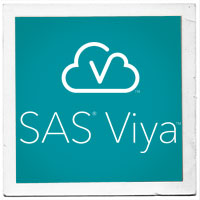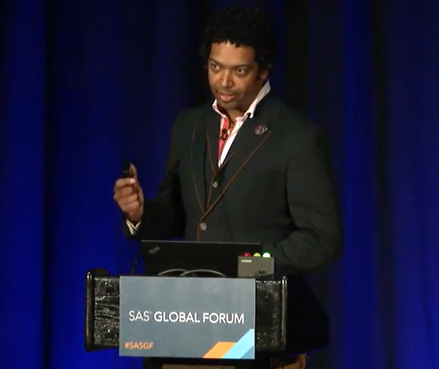SAS Viya is our latest extension of the SAS Platform and interoperable with SAS® 9.4. Designed to enable analytics to the enterprise, it seamlessly scales for data of any size, type, speed and complexity. It was also a star at this year’s SAS Global Forum 2018. In this series of articles, we will review several of the most interesting SAS Viya talks from the event. Our first installment reviews Hadley Christoffels’ talk, A Need For Speed: Loading Data via the Cloud.
is our latest extension of the SAS Platform and interoperable with SAS® 9.4. Designed to enable analytics to the enterprise, it seamlessly scales for data of any size, type, speed and complexity. It was also a star at this year’s SAS Global Forum 2018. In this series of articles, we will review several of the most interesting SAS Viya talks from the event. Our first installment reviews Hadley Christoffels’ talk, A Need For Speed: Loading Data via the Cloud.
You can read all the articles in this series or check out the individual interviews by clicking on the titles below:
Part 1: Technology that gets the most from the Cloud.
Part 2: Is there a “Big Red Button” to use The SAS Platform?
Technology that gets the most from the Cloud
 Few would argue about the value the effective use of data can bring an organization. Advancements in analytics, particularly in areas like artificial intelligence and machine learning, allow organizations to analyze more complex data and deliver faster, more accurate results.
Few would argue about the value the effective use of data can bring an organization. Advancements in analytics, particularly in areas like artificial intelligence and machine learning, allow organizations to analyze more complex data and deliver faster, more accurate results.
However, in his SAS Global Forum 2018 paper, A Need For Speed: Loading Data via the Cloud, Hadley Christoffels, CEO of Boemska, reminded the audience that 80 percent of an analyst’s time is still spent on the data. Getting insight from your data is where the magic happens, but the real value of powerful analytical methods like artificial intelligence and machine learning can only be realized when “you shorten the load cycle the quicker you get to value.”
Data Management is critical and still the most common area of investment in analytical software, making data management a primary responsibility of today’s data scientist. “Before you can get to any value the data has to be collected, has to be transformed, has to be enriched, has to be cleansed and has to be loaded before it can be consumed.”
Benefits of cloud adoption
The cloud can help, to a degree. According to Christoffels, “cloud adoption has become a strategic imperative for enterprises.” The advantages of moving to a cloud architecture are many, but the two greatest are elasticity and scalability.
Elasticity, defined by Christoffels, allows you to dynamically provision or remove virtual machines (VM), while scalability refers to increasing or decreasing capacity within existing infrastructure by scaling vertically, moving the workload to a bigger or smaller VM, or horizontally, by provisioning additional VM’s and distributing the application load between them.
“I can stand up VMs in a matter of seconds, I can add more servers when I need it, I can get a bigger one when I need it and a smaller one when I don’t, but, especially when it comes to horizontal scaling, you need technology that can make the most of it.” Cloud-readiness and multi-threaded processing make SAS® Viya® the perfect tool to take advantage of the benefits of “clouding up.”
SAS® Viya® can addresses complex analytical challenges and speed up data management processes. “If you have software that can only run on a single instance, then scaling horizontally means nothing to you because you can’t make use of that multi-threaded, parallel environment. SAS Viya is one of those technologies,” Christoffels said.
Challenges you need to consider
According to Christoffels, it’s important, when moving your processing to the cloud, that you understand and address existing performance challenges and whether it will meet your business needs in an agile manner. Inefficiencies on-premise are annoying; inefficiencies in the cloud are annoying and costly, since you pay for that resource.
It’s not the best use of the architecture to take what you have on premise and just shift it. “Finding and improving and eliminating inefficiencies is a massive part in cutting down the time data takes to load.”
Boemska, Christoffels’ company, has tools to help businesses find inefficiencies and understand the impact users have on the environment, including:
- Real-time diagnostics looking at CPU Usage, Memory Usage, SAS Workload, etc.
- Insight and comparison provides a historic view in a certain timeframe, essential when trying to optimize and shave off costly time when working in cloud.
- Utilization reports to better understand how the platform is used.
Optimizing inefficiencies with SAS Viya
But scaling vertically and horizontally from cloud-based infrastructure to speed the loading and data management process solves only part of the problem. Christoffels said SAS Viya capabilities completes the picture. SAS Viya offers a number of benefits in a Cloud infrastructure, Christoffels said. Code amendments that make use of the new techniques and benefits now available in SAS Viya, such as the multi-threaded DATA step or CAS Action Sets, can be extremely powerful.
One simple example of the benefits of SAS Viya, Christoffels said, is that with in-memory processing, PROC SORT is a procedure that’s no longer needed; SAS Viya does “grouping on the fly,” meaning you can remove sort routines from existing programs, which of itself, can cut down processing time significantly.
As a SAS Programmer, just the fact that SAS Viya can run multithreaded, the fact that you don’t have to do these sorts, the way it handles grouping on the fly, the fact that multithreaded nature and capability is built into how you deal with tables are all “significant,” according to Christoffels.
Conclusion
Data preparation and load processes have a direct impact on how applications can begin and subsequently complete. Many organizations are using the Cloud platform to speed up the process, but to take full advantage of the infrastructure you have to apply the right software technology. SAS Viya enables the full realization of Cloud benefits through performance improvements, such as the transposing of data and the transformation of data using the DATA step or CAS Action Sets.
Additional Resources
- SAS Global Forum Video: A Need For Speed: Loading Data via the Cloud
- SAS Global Forum 2018 Paper: A Need For Speed: Loading Data via the Cloud
- SAS Viya
- SAS Viya Products

1 Comment
Very informative, and the way AI can be used is dazzling; hope the world uses it in a positive way for peace and prosperity for humans and living entities that over breed to destroy or under breed to extinction!